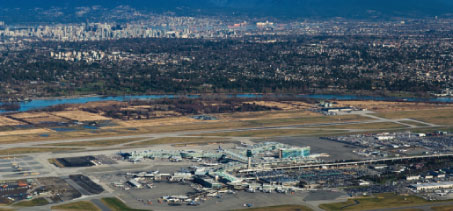
Vancouver and the Province of British Columbia are well known for their spectacular beauty. YVR is 15km from downtown Vancouver and 115km from the Resort Municipality of Whistler – the two primary locations of the Vancouver 2010 Olympic and Paralympic Winter Games.
Vancouver Airport Authority’s strategy since its inception in 1992 has been to develop YVR as a global gateway between Asia and the Americas. This is based on a number of strengths, notably its geographical advantages, its infrastructure and its large Asian demographic. YVR is the fourth-largest North American market to Asia and has more frequencies to China than any other point in North America. 25% of Vancouver’s metropolitan area of 2.3 million is of Asian heritage, predominantly Hong Kong, Taiwan, China and India, and in some cases that figure is as high as 85%.
“Part of our strategy is also to continue to identify and work towards removing impediments to growth, such as restrictive air transport agreements (bilaterals) and passenger facilitation issues such as Transit Without Visa (TWOV),” explained John Korenic, director, Aviation Marketing, Vancouver Airport Authority. “On this front we welcomed the new liberal bilaterals with Europe and Korea, however, we still identify a number of restrictive agreements.”
Vancouver Airport Authority also recognises the need for added capacity to Europe. European traffic performed well during the economic crisis and load factors over the past five years have been in the region of 89-90%. “Our local tourism industry consistently tells us that there is not enough lift into YVR from Europe. The UK is the biggest market, followed by Germany, the Netherlands and France,” said Korenic.
YVR is 15km from downtown Vancouver and 115km from the Resort Municipality of Whistler – the two primary locations of the Vancouver 2010 Olympic and Paralympic Winter Games. The event was a pivotal focus of the Airport Authority and its partners for three years leading up to the Winter Olympics. Indeed, the Authority signed on as a sponsor, being an ‘Official Supplier’ to the Games – the first time an airport had taken such a step.
“Corporately, we ensured that we had all hands on deck at YVR to assist with the handling of additional passengers, athletes and officials. This included staff from various departments – finance, marketing, legal, etc, and involved considerable operational and customer service training. This is one of our legacies from the Games,” said Korenic. “On our radar was ‘departure’ day – 1 March – the day after the closing ceremonies, when there was an outflux of 39,000 passengers – a record for departing passengers handled in one day. All went extremely well; however, this didn’t just happen – it was the result of very meticulous planning.”
The Vancouver 2010 Olympics placed Vancouver and YVR on the world stage with 3.5 billion viewers worldwide. It generated significant awareness, particularly in Europe, the US and Australia.
The Airport Authority and its airline partners are developing strategies to strengthen Canada’s Pacific gateway. Significantly, the Authority recently announced that it will offer airlines a five-year incentive programme designed to increase routes and capacity to YVR. Under the programme, participating air carriers can add capacity without incurring additional landing and terminal fees. It is expected that the resulting capacity increase will add the equivalent of 8 to 10 new international daily flights, or approximately 1.1 million additional airline seats over the next five years.
It has also been announced that the provincial fuel tax will be eliminated. In conjunction with other initiatives, it will enhance the airport’s cost competitiveness, particularly in light of YVR having the lowest aeronautical fees among Canada’s major airports.
These incentives and developments put YVR in a strong position to continue its positive passenger performance. Passenger volumes have rebounded strongly since May, with particular strength noted on Asia Pacific and transborder routes. The trend going into 2011 appears to be for further growth, with throughput expected to reach 17.4 million.







